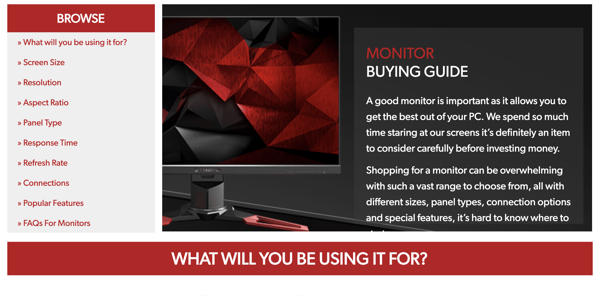
You may not realise it, but you’re already a content marketer.
L&D and content marketing have a lot in common and in this post, I'll be breaking those down into quite a bit of detail.
So grab your coffee ☕ (or wine 🍷) and let's get started.
Think about the last time you bought something online. Let’s say it was a monitor for your computer.
I’m going to bet that you didn’t go straight to an online store and randomly pick a screen.
You probably started your journey to becoming the owner of a brand new computer monitor by doing a Google search. Your search might include keywords like ‘laptop monitor’, ‘types of laptop monitors’, ‘best laptop monitors in 2020 for less than £200’.
Shortly after that search, you start getting those annoying popup ads (that’s called retargeting). You ignore them because they’re trying to sell you something you’re not ready to buy just yet. They’re interrupting you. But we’ll come back to this.
You start reading different blogs, reviews and watching videos on Youtube about how to choose a monitor. Before you know it, you’re pretty educated about monitors. They come in all sorts of sizes, shapes, aspect ratios, panel types, connections and warranties.
You come across a handy guide from Laptops Direct.

The guide's really help and now you’ve narrowed down to a selection of monitors that are within your budget and suit your needs.
Now it's time to shop. You go to Google and now you type in ‘buy Lenovo D22-10 21.5" Full HD Monitor’.
You get lots of search results. But guess who's in the first top five search results? Yep - Laptops Direct. The nice people who created that handy guide that saved you quite a bit of time.

You already like their content, you trusted the advice they gave you and you can see their competitively priced. So you buy your Lenovo monitor from them.
That's how content marketing works.
Content marketing is all about creating valuable, educational content for your audience.
It’s about pulling your audience to your website through content rather than interrupting them with ads when they’re just not ready to buy yet.
That content is what enables you to build trust with them. But it has to be great content.
Once the trust is built, when they're ready to buy, they'll come back to you.
Let’s say you’re a salesperson at a tech company. You’re having a little trouble demoing the software your company sells. What do you do?
If you have a searchable platform, portal or intranet, you’d probably do a search for terms like ‘how to demo X’, ‘best examples of X demo’.
It's unlikely you'd email your line manager and ask her to send you for some training right?
You'd want to learn from the top sales people in your team and you want to learn fast. Why? Because the sooner you can nail that demo, the sooner you'll start making sales and hence money.
As a salesperson, you want the most efficient solution and you want to be able to find it quickly.
As a content marketer, my north star is the sales pipeline. Any content I create is aimed at getting the right people into our sales funnel. We’ll talk about who the ‘right people’ are in the next point.
Just like learning initiatives, the end goal of content marketing is to drive a business metric through engaging with your target audience in a meaningful way. So like any learning initiative, content marketing initiatives start with SMART goals:
Here’s an example of a SMART goal I would use around increasing blog traffic:
Just like in the world of L&D, once we’ve established the business goals and content marketing goals, it’s time to get to know our audiences.
This is where tools like personas, empathy mapping and ‘Jobs to be Done’ can be really useful.
I want to know as much as I can about my audience. Apart from standard things like demographics, job role etc., I want to know:
As a content marketer, a thorough understanding of my audience is the foundation of my content strategy. Without it, I’ll just end up creating content that my audience won’t relate to and won’t get any value from.
There’s another really important reason it’s so important to understand your audience as a content marketer. You don’t want to send the wrong people down your pipeline.
Whilst I want my content to be useful to as many people as possible, I only want to drive people who would truly benefit from and be able to afford to buy what i’m selling down the pipeline. Otherwise, I’d be wasting their time and the time and resources of our sales team.
Content is only one part of marketing. Just like it’s only one part of a learning strategy.
But it’s an important part. In my world, content will include things like blogs, videos, podcasts, social media posts, white papers, guides and ebooks.
As a content marketer, my aim is to create content that is relevant to my audience, is valuable for them and is easily searchable. Let’s break these down:
I recently interviewed a Learning Experience Designer for our podcast (if you’d like to join me as a guest, drop me a line!). We were talking about the parallels between marketing and L&D.
He was telling me how he exports search terms from Salesforce’s knowledge base to understand what the sales team were searching for. That way he could go back and make his learning content more searchable.
He changed the titles, keywords and tags he used. This meant that more relevant content was being surfaced for the sales team. They were able to get the answers to their questions quicker and get back to what they’re hired to do: sell.
So far, we’ve made sure we’re aligned to business objectives, we’ve researched our audiences and we’ve created content that’s valuable, relevant and searchable.
Now we need to get our audience to engage with the content. But not just any engagement. We want active engagement.
Active engagement is when people comment with something meaningful, share the content or reach out and have conversations about it.
Unlike passive engagement where someone might just view or like a piece of content, active engagement really drives a conversation in some way adding further value than what was provided in the content itself.
If you want to find out more about active and passive engagement, check out this article.
One great way to drive engagement is through using call to actions (CTAs). This is when you ask your audience to do something specific when they’re consuming your content.
For example, at the end of this blog post, I’m going to ask you to leave a comment and let me know if you found this blog useful and if so, which part specifically.
A good CTA is specific, actionable and clear. CTAs are underused in the world of learning yet they can really help drive engagement.
A regular drumbeat of content is the lifeblood of a good content and learning strategy. It's the key to sustaining engagement.
For example, I publish blog posts twice a week, publish a new podcast episode once a week and run a LinkedIn live once a week.
But here's my dirty little secret: I don't always create brand new content. Sometimes I repurpose what I already have. And there's no shame in that.
For example, I'll turn a LinkedIn Live recording into a podcast or a blog post. People like to consume content in different formats so it's good to repurpose.
It's important to have a balance of new vs repurposed content. I generally follow an 80:20 split (80% new and 20% repurposed).
I know we already talked about aligning with the business and the importance of SMART goals.
I’m bringing measurement up again as it’s something that should be happening throughout the lifetime of a content or learning campaign.
Let’s go back to the SMART goal example I shared in point 1:
I want to increase our blog's traffic by 10% by the end of Q4. We’ll do this by increasing our publishing frequency from 4 to 6 times a week with the aim of boosting brand awareness and generating more leads, giving sales more opportunities to close.
I need to be constantly measuring blog traffic and conversions to make sure we’re on track to achieving that goal.
I’d be looking at my analytics dashboards daily to see if the increased frequency is indeed delivering on the increase in traffic.
I’d take it a step further though. As traffic starts to increase, I’d also closely monitor the leads that are being passed on to the sales team.
If the traffic is increasing but conversion rates are decreasing, it means the content we’re producing is not attracting the right audience for us.
If that’s the case, I’d run experiments to test that assumption.
It’s an ongoing cycle of iterate - measure - iterate - measure.
There are lots of other things our worlds have in common. But I'm conscious this has been a long post!
Given you've come this far, I'll go out on a limb and assume you found some value in it. I'd love to know what that was. And if you think I've missed anything, let me know!
Just leave me a comment below or we can connect on LinkedIn. I'd love to have a conversation with you!
© 2022 Fuse Universal - All Rights Reserved
Comments (10)